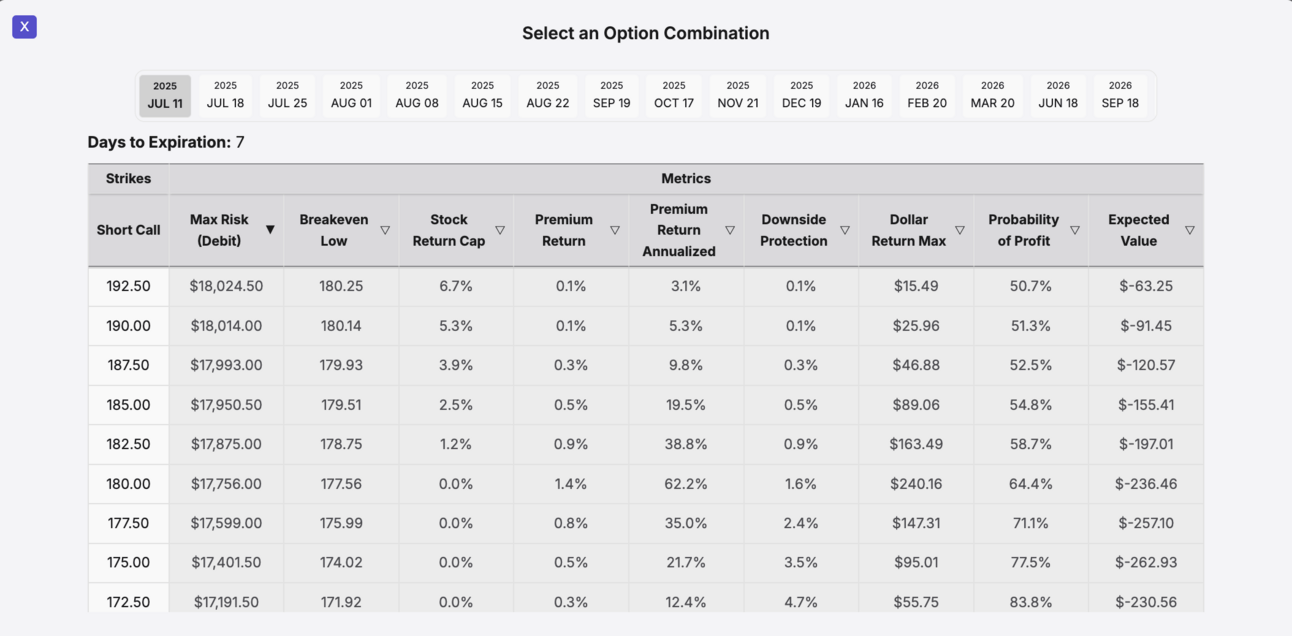This weeks topic:
Covered Calls
It’s what got us into options in the first place, and also the first post that blew up on Reddit which sparked the idea for OptionTerminal.com!
So what are covered calls? Below we dive into covered calls to try and hit all the fundamentals one may need to understand.
Important! Remember this is not financial advice, rather an educational blog post by option fanatics aiming to write down our knowledge gained over a combined 16 years of trading.
Covered Calls: Simple Strategy, Complex Outcomes
Covered calls are often pitched as a conservative way to generate income: “rent” your stocks, collect premium, repeat. But behind that simplicity is a deeply layered strategy that responds to volatility, path dependency, and market structure in surprisingly nuanced ways. In this deep dive, we’ll unpack why covered calls are far more than an income generator, and how OptionTerminal can help you navigate their complexity with precision.
Covered Calls = Long Delta, Short Vol
At the core, a covered call involves holding a long stock position and selling a call option against it. Mathematically, this creates a position with positive delta (you're long the stock) and negative vega (you're short implied volatility). You are giving up some upside in exchange for premium, and that tradeoff shapes every aspect of the strategy’s payoff and risk.
Let’s walk through a basic setup:
Stock: GOOG at $150
Sell 1-month 160 call for $2.00
Max upside: $12 (gain to 160 plus $2 premium)
Breakeven: $148
Downside: Fully exposed like long stock, just $2 lower due to premium (what we call “Downside Protection”)
This setup may feel safe but under the hood, you’re exposed to a number of second-order effects that influence long-term outcomes more than the premium itself.
Take a look below👇, here is how you can use option terminal to sort by these metrics and choose the best contract to fit your needs:

Volatility: The Real Driver of P&L
One of the most important insights from advanced covered call studies is this: most 1-month option P&L comes from realized volatility, not theta decay. In other words, it’s not just time passing that pays you; it’s whether the stock behaves “better” (i.e., moves less) than the market priced in.
Enter the Volatility Risk Premium (VRP)
The VRP is the difference between implied volatility (IV, or what the market thinks volatility will be) and realized volatility (what ended up happening). Selling options is profitable when IV exceeds realized vol, in other words, when the market overprices risk. For covered calls, this is the core engine of P&L over time.
When OptionTerminal runs covered call optimizations, it evaluates different strike selections and entry points based on implied volatility surfaces. You can see how much of the strategy’s return comes from directional moves vs volatility capture.

Risk Management is crucial…
Covered call backtests can be misleading without context:
When you roll/close a position is everything
Were they closed early or held to expiration?
Were taxes, slippage, fees, and early assignment modeled?
Small choices = big differences in results.
If you would like help in running your own covered call backtest, write to us on socials (Instagram: @OptionTerminal, X: OptionTerminal, or email: info@optionterminal.com)
The Real Takeaway: Covered Calls Are Not Passive
Covered calls are an active volatility trade, not just passive income. They perform best when:
IV is high relative to realized vol
The stock has moderate upside, not breakouts
You're disciplined about risk management and selection
Final Thoughts
Whether you’re a beginner writing your first call or an advanced trader thinking about VRP and skew, covered calls reward those who respect their complexity.
They're not "free money," but they can be a persistent source of edge if you:
Monitor volatility dynamics
Understand when and how to optimize your roll
Normalize for risk
Avoid overfitting entry signals
OptionTerminal makes this process transparent: with live market data, payoff comparisons, and strategy optimizations across multiple metrics. Try simulating covered calls on your top holdings and see how subtle changes affect outcome distribution. Income never looked so dynamic.
Ready to see how your covered calls really perform? Visit the website (OptionTerminal.com) and start optimizing.
That’s it for this week.
Keep spreading the word, giving us feedback, and being responsible in your trading.
The OptionTerminal team
P.S.
We are always working on adding new features - if you have any ideas that would be helpful to you, let us know and we will try to integrate it into the website so everyone can benefit from it.
